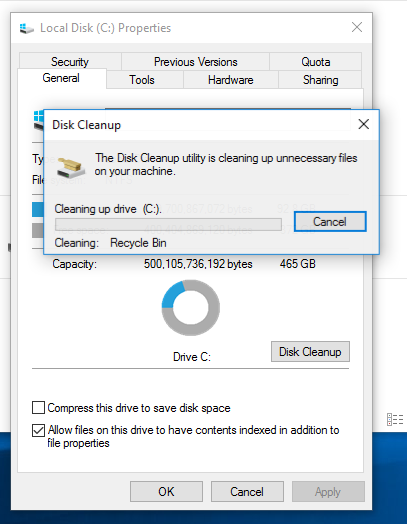

Suppose you are selling your disks or you need to erase your portable drive.
#Clean disk space linux how to#
Removing and hiding file in a single command How to wipe a disk or partition with shred In the file removal steps, the file name is also mutated so it is non-discoverable.

In the final pass, the file is overwritten with all zeros. In the output below, the file is overwritten 5 times. We don't need to remove file afterwards using rm with this flag.

Let's check out the contents of the shredded file: cat poem.txt Here, we can see that file has gone through 3 overwrites Let's overwrite its contents using the default three passes: shred -v poem.txt Here, -v stands for verbose and shows detailed output. We have a sample file poem.txt whose contents are shared below: Contents of sample file poem.txt How to overwrite and delete a file with shred Please be careful, as contents are not recoverable. ⚠️ Before running any of the examples on your system, ensure that your file and filesystem is properly backed-up. It can be used by sys admins, digital forensics teams, or information security specialists to enforce security standards. You use the shred command to erase sensitive data, which ensures security as well. The default pass value can be changed as well by using the -n flag. The three passes ensure that the file is overwritten three times. The shred command makes the file go through three passes by default. Whereas rm simply removes the pointer to file system. Depending on the number of iterations and file/disk size, shred can take longer. This is because shred overwrites the file a couple of times before deleting it. We'll see that in examples later on.Īnother difference is the speed of execution. So there is a possibility for data recovery.īut when you use the shred command, the file is overwritten a specified number of times in a way that the actual content is unrecoverable. Simply using rm removes the pointer to the filesystem.

In the example above, replace the path with your disk path. Truncate and remove file after overwriting. Instead of the default (3) times, overwrite the data N times.Īdd a final overwrite with zeros to hide shredding.įorce the permissions to allow writing if necessary. Syntax of Linux shred command: shred filename shredding a 'file' shred -vfz shredding a 'disk'Īccording to the man page, some of the you can use with shred are: That is why it's commonly used to securely remove data.
#Clean disk space linux software#
This makes it harder for third party software and hardware probing to recover the data. The shred command helps to overwrite the data in place several times. In this blog post, we will study a new command known as shred which helps us to wipe out disks and clear files in a secure way. You can read in detail about the rm command here. The most common command to delete files and folders is rm and rmdir, respectively. And Linux provides a number of utilities to delete files and folders from the command line. Removing files and formatting disks is a common task for users.


 0 kommentar(er)
0 kommentar(er)
